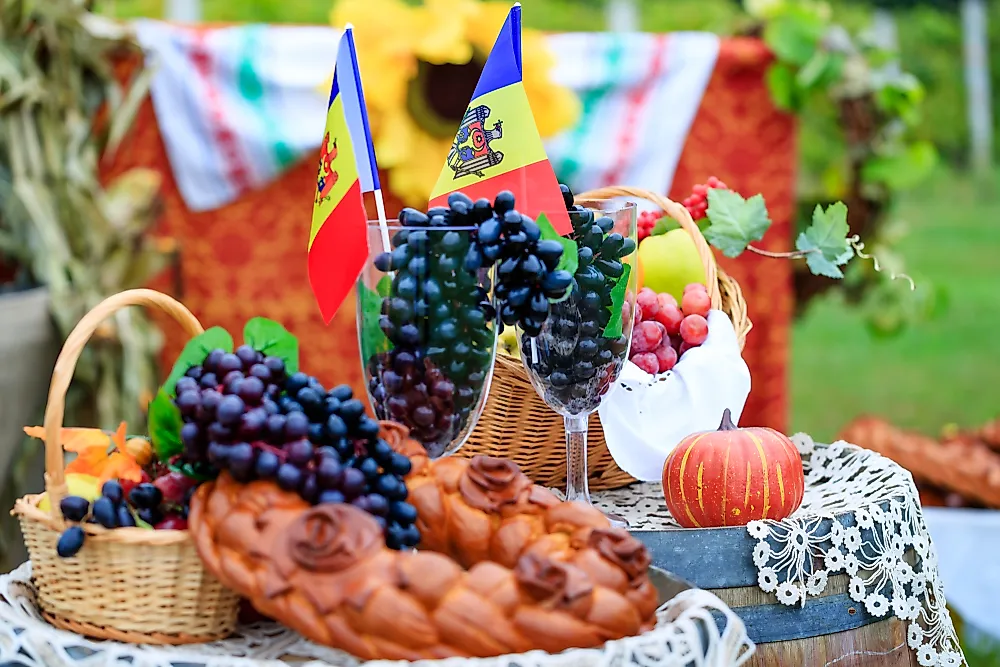The Culture Of Moldova

The landlocked Eastern European country of Moldova hosts a population of around 3,437,720 inhabitants. Ethnic Moldovans comprise 75.1% of the total population of the country. Romanians, Ukrainians, Russians, Bulgarians, and others constitute the rest of the country’s population. 90.1% of the population adhere to Orthodox Christianity.
5. Cuisine in Moldova
The country's cuisine mainly features traditional European foods like pork, beef, cabbage, cereals, and potatoes. Vast tracts of fertile soil also allow the cultivation of a number of fruits and vegetables that find their way into the Moldovan cuisine.
The mămăligă (a type of porridge) is a staple of the cuisine and is usually served with meat dishes or stews. Sour cream, cheese, or pork rind are used to garnish it. Other popular food items include the ghiveci (a goat or lamb stew) and brânză (brined cheese), beef meatballs, grilled pork, stuffed cabbage rolls, noodles, chicken, etc.
Cuisines of the ethnic minorities are predominant in certain areas of the country where the respective minority communities live in large numbers. For example, meat-filled dumplings called pelmeni are eaten by the Russian community, and a mutton soup called shorpa is consumed by the Gagauz peoples.
Beer, Moldovan brandy, and local wine are popular alcoholic beverages. Fruit juice and stewed-fruit compotes are widely consumed non-alcoholic beverages.
4. Literature and Graphic Arts in Moldova
Prior to the development of written literature, oral literature was prevalent in the country in the form of folk legends, fairy tales, historical songs, heroic epics, ballads, lyrical songs, etc. The first written records in the form of historical and sacred texts appeared in the country in the Old Church Slavonic language. Secular literature developed in Moldova at around the end of the 17th century. The Romanian and Moldovan literature of this time exhibits significant overlap.
Paintings in monasteries and 16th-century icons are the oldest examples of Moldovan art. Bessarabian arts flourished in the 19th and 20th centuries. Such art concentrated on rural themes and landscapes. Today, Moldovan artists explore various genres of art. The presence of art galleries and art schools throughout Moldova encourage young artists to pursue their career in art.
3. Performing Arts in Moldova
The music tradition of Moldova is closely related to that of its neighbor, Romania. Folk and classical music are popular in the country while jazz is also widely performed. The folk music of the country is associated with syncopation, complex and swift rhythms, and melodic ornamentation. O-Zone is a popular Moldovan pop band. Folk music and dance performances are held during cultural festivals and ceremonies. Rock and pop concerts are held in urban areas and are popular among the Moldovan youth.
2. Sports in Moldova
Football is the most popular sports in Moldova. The Zimbru Stadium in Chișinău serves as the home ground of the country’s national football team. Moldova also performs well in basketball and its national team has earned some success in the FIBA European Championship for Small Countries. Cycling is also an important sport in Moldova. The Moldova President's Cup is a prestigious annual cycling race held in the country. Moldovan sportsmen in the fields of boxing, canoeing, shooting, and wrestling have won some Olympic medals for the country.
1. Life in a Moldovan Society
The Moldovan law provides men and women equal rights and freedoms. Members of both genders work outside the home. However, women are usually expected to manage the household chores and children in addition to their jobs. While men have higher decision-making power than women, the latter act as organizers in daily life.
Marriages are generally based on romantic relationships. Once the couple decides to marry, families are usually involved to agree on the marriage. Divorces are not uncommon in a Moldovan society.
Residences are primarily patrilocal in nature. The newlyweds live with the family of the groom. Later, they might move out if they build a home elsewhere. In the rural areas, the traditional society maintains the rule that the youngest son inherits the paternal home but he has to take care of his elderly parents.
Mothers and other female members of the family take care of the children. Grandparent-grandchildren relationships are highly valued in Moldovan society.
While the urban Moldovan society closely resembles that in many parts of the Western world, more traditional ways of life are visible in the rural areas of the country. In villages, the sight of women smoking in public is frowned upon. Men refrain from smoking inside the home and consider it polite to go outside to smoke. People in villages greet each other with respect and politeness.











